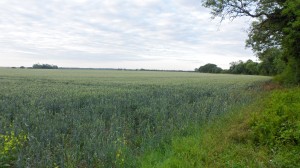 This photograph makes my BBS square look about as pretty as I can given the fact that it consists of large fields of wheat.
This photograph makes my BBS square look about as pretty as I can given the fact that it consists of large fields of wheat.
On Friday morning I completed my second BBS visit – it’s a bit late but it would have been a bit difficult to come back from the USA early to count farmland birds for the BTO and the RSPB.
This year’s species total (24) is the equal lowest of the 7 years I have surveyed this square, but nothing to worry about by the look of it. It hasn’t been a particularly good year for any of the species and Friday’s visit was pretty quiet.
Looking in a little more detail, but this is hardly a scientific analysis, compared with 2005, the first year I covered this particular square, 4 species were commoner this year (buzzard, pheasant, collared dove and dunnock), 4 species were equally abundant (chiffchaff, magpie, goldfinch and bullfinch) whereas 22 species were rarer (mallard, lapwing, stock dove, wood pigeon, tawny owl, swift, skylark, wren, robin, great tit, blue tit, long-tailed tit, willow warbler, blackbird, blackcap, jackdaw, carrion crow, starling, chaffinch, greenfinch, linnet and yellowhammer). But each year is different, so I wouldn’t read much into this longer list of declines for my square – what is important is the overall trend across all those thousands of sites surveyed, free of charge, by volunteers like myself.
But if those overall results show continuing declines in farmland birds then I cannot do much about it, despite the fact that my taxes are going into these wheat fields, except by asking the government and the EU to spend my taxes better on encouraging farming practices that will boost bird numbers. I don’t mind paying for this, what I do mind is paying for the declines.
[registration_form]
Good to see you doing some field ornithology Mark. It’s a great way to start the day.
Luckily my wife is a keen birder as well so we do our surveys together. With another friend we have one more visit to complete 13 tetrads for the BTO Atlas. The two of us also do the RSPB Volunteer and Farmer Alliance surveys (just finished for this year) and we are also just about to complete a 10 visit survey of all the hedges and ditches on our local RSPB Reserve (8 morning starts and two evenings with three other teams). The last two surveys we try to start at half an hour after sunrise, At my age (over seventy) there are other pressures that get me up early anyway! Having done 10yrs with the V&FA it is very interesting to work with farmers. The demand is such that not all farmers asking for a survey can be covered each year. It is very obvious to me that many farmers are very keen on conservation and take very seriously their stewardship of the countryside. Several of our farms have had game shoots and the latest one had a full time gamekeeper. Very often the best areas on the farm are the game cover areas. However it has struck me that modern day farmers aren’t very familiar with wildlife that’s around, too much time spent in air-conditioned tractors perhaps and lack of opportunity for observation. They know their skylarks, yellowhammers and lapwings but are surprised at the number of warblers, especially willow warblers and lesser whitethroats etc. I know that they use the results to improve their chances of funding but I believe the interest is deeper than that.
I too have signed the letter to Barrosa.
Regards, Richard.
Richard – thank you. You are busy – well done!
The RSPB’s Volunteer and Farmer Alliance is a great initiative which puts farmers with an interest in nature together with RSPB volunteers who do bird surveys of their farms. Maybe I shouldn’t say it’s a great thing as I had a lot to do with getting it started and finding the money, over a quarter of a million pounds a year, to keep it going. And I am sometimes said to be anti-farmer! The VFA reaches out to those farmers who want to know more about the birds on their farms so it works with some of the most keen, most aware and most in-tune farmers and that has to be a good thing.
You are right that the knowledge of birds amongst farmers is very variable – why should it not be? My experience is that pheasants, partridges, barn owls and lapwings are quite well known but anything a bit smaller is usually off the radar. If you have a conversation with a farmer about yellowhammers then that is a pretty clued up farmer. And the VFA does help some farmers become more clued up, and also, I bet, you have learned a bit about farming and the struggles faced by farmers through doing the VFA surveys too – I know I did. And I have made some friends in the local farming community through those surveys too – despite the fact that we can still differ over some policy issues.
And game cover is often very good for birds and other wildlife – that’s why it is now funded through Pillar 2 payments (the ones we want to keep even though they are under threat).
Thank you for writing to Pres Barroso.